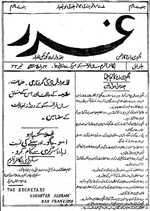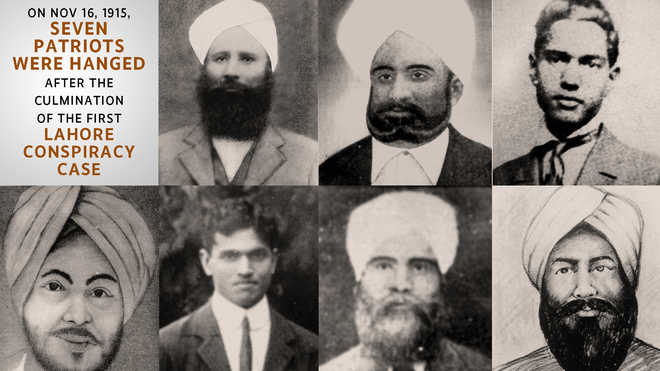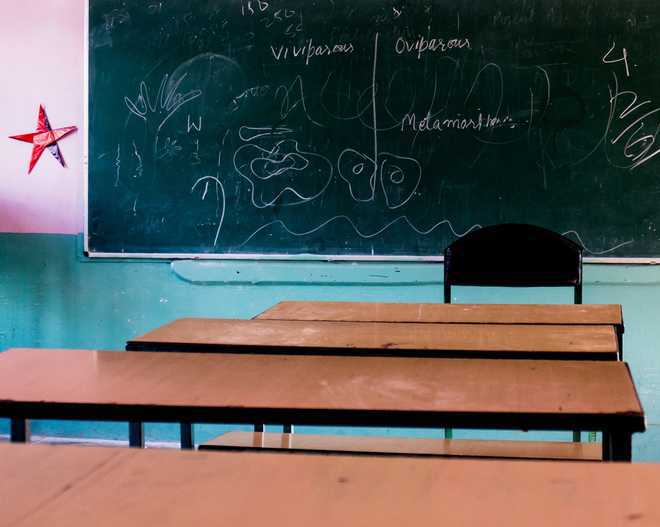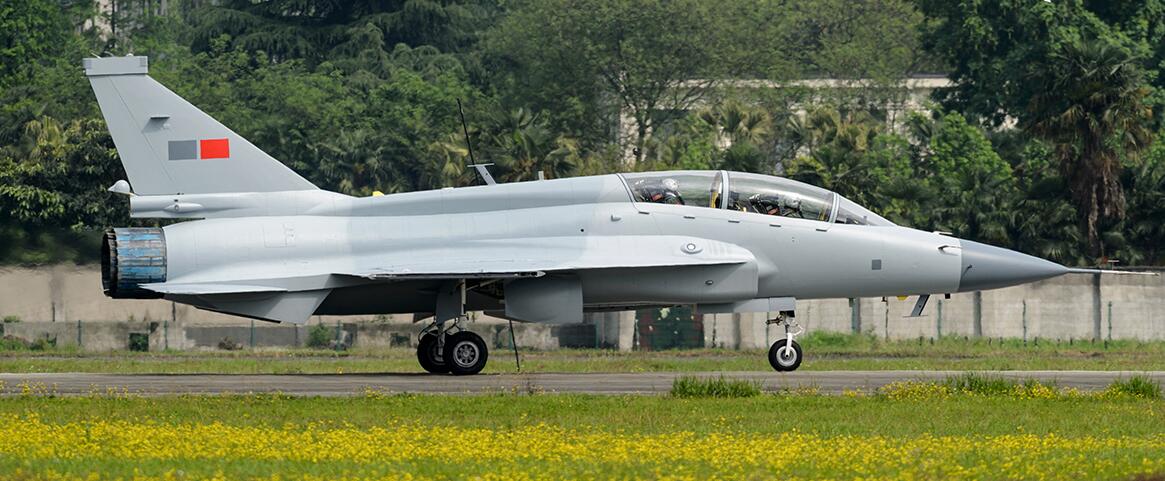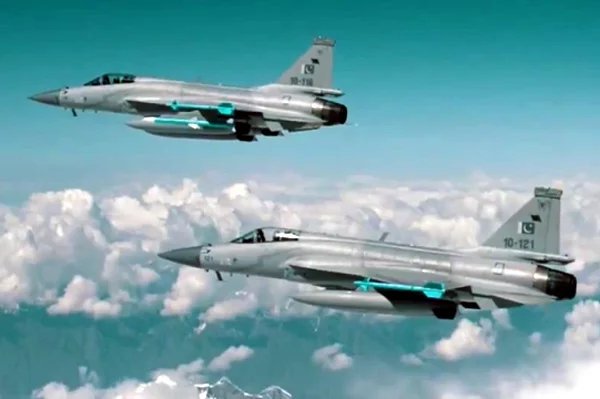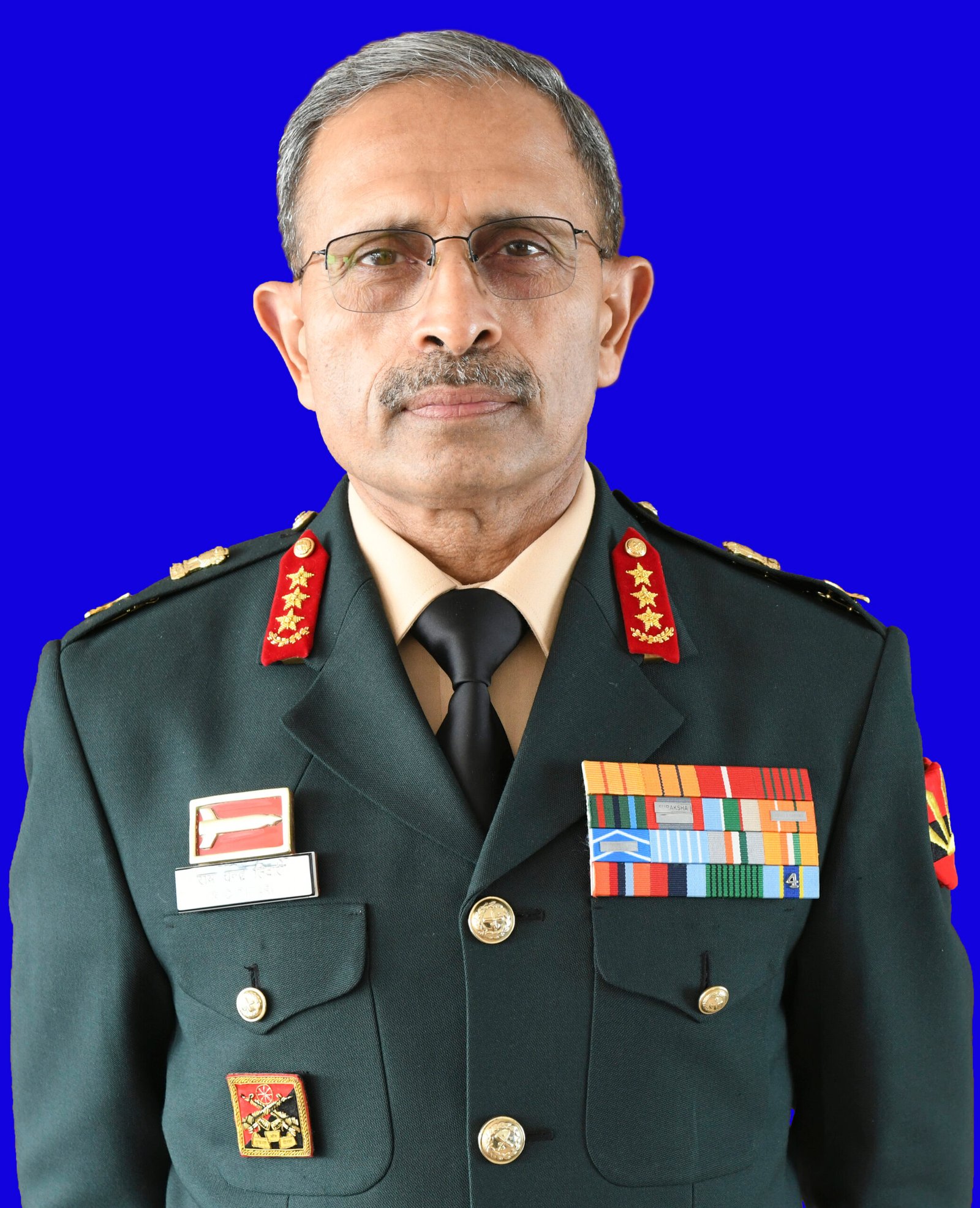(Clockwise from top left) Harnam Singh Sialkoti, Jagat Singh Sursingh, Kartar Singh Sarabha, Suren Singh Gilwali (senior), Bakhshish Singh Gilwali, Vishnu Ganesh Pingle, Surain Singh Gilwali
Ravjot Grewal
A little more than a hundred years ago, on November 16, 1915, seven patriots were hanged to death after the culmination of what became popular as the first Lahore Conspiracy Case. These included Bakshish Singh, Jagat Singh, Vishnu Ganesh Pingle, Surain Singh s/o Boor Singh, Surain Singh s/o Ishar Singh, Harnam Singh and Kartar Singh Sarabha. These trials were to have an enduring impact on the psyche of Punjab and reverberations on India’s history. These hangings by the colonial government were one of the many in order to curb the war declared by the Ghadarites on the colonial government in India in February of 1915.
Events that led to Ghadar
A week after Britain declared war on Germany on August 4, 1914, a clarion call had appeared in Ghadar, a weekly revolutionary newspaper published from San Francisco, summoning its overseas Indian readers to return to their homeland and fight. It said the opportunity to free their country from slavery had arrived.
This was so because Britain was quite vulnerable due to depletion of troops and resources. Also, its arch-enemy Germany was offering support to various revolutionary movements which had the potential of undermining the strength of the Empire. These included the Indian and Irish national revolutionists and the pro-Ottoman pan-Islamists. This was how the Ghadar Movement was launched among the Punjabi migrant workers in North America in 1913. It was characterised by a predominant Punjabi male participation and was a ringing explosion in the ears of the imperial government of the time.
The Ghadar Party was established by the Punjabi Sikhs of the USA and Canada in June 1913 also known as the Hindi Association of the Pacific Coast. The word ‘Ghadar’ means “mutiny” or “rebellion” or “revolt”. On November 1, 1913, the Ghadar Party issued their first newspaper from University of California in Berkeley. This party was originally built around the weekly paper Ghadar. For the first time, a true picture of the British rule was shown in the journal, simultaneously enunciating a vision for the future of India. In fact, the founders envisioned that the Ghadar would do the work of preparing the Indians for revolt until the actual war.
Today, it is important to remember the martyrs and the specific conditions that led the erstwhile loyal ‘Sikhs’ to turn against their imperial benefactors. At the heart of the movement was the Punjabi farmer-soldier-turned-labourer abroad, driven out by the accretion of economic problems at home.
In the decade before the seeds of this large-scale unrest were sown by the imperial government in Punjab, the agrarian legislation, the colonisation Bill, issues of water rates and enhancement of land revenue had largely contributed to Punjabi men being forced to migrate in search of economic opportunities. At the same time the Indian National Association, the Indian National Congress, the Swadeshi Movement and the activities of Zamindara League (Unionist Party) had contributed to the political awakening of the Punjabis.
The Sikh connection
It is a curious question of history as to how the Sikh community in Punjab which was given the distinction of being a ‘martial race’ by the British, turned around to demand complete independence and plan a violent stratagem against their benefactors. The spectacular display of material prosperity, the spring of freedom in the steps of white people and the opportunities of economic mobility in the USA and Canada led the pioneer migrants to understand their own depravity induced by slavery to an imperial power. The white Canadians and Americans believed that they belonged to a superior and civilised race whereas Indians and other Asians were considered uncivilised.
During the first decade of the 20th century, 5,000 Indians reached Canada. Out of these more than 90 per cent were Sikhs. The harsh racial differentiation, violent attacks by white labourers and hoodlums led to a feeling of humiliation and shame among these Indian migrants. They believed they were subjected to this treatment because they were citizens of a slave nation. The British at that time did not want Indians associating or interacting with white people. This led to measures being taken by the Canadian government, then a colony of Britain, discouraging immigration from India. The freedom offered by these countries to the migrants propelled the transition to a demand for a more just social order.
These socio-political conditions led to the birth of the Ghadar Party, a party that gave expression to the evolved understanding of the repercussions of colonial rule in India. Although strict interpretation of its character is difficult without being unfair to its secular participants, numerically the Ghadar was largely a Sikh movement. The Komagata Maru incident was the final spark that ignited an already inflamed Sikh pride. The aftermath of this incident was a burst of revolutionary activity in the migrant Sikhs to redeem themselves from both the shame of allegiance to the British government in 1857 and their own cursed status as a slave nation.
Literary legacy
The Ghadar was no ordinary movement neither in its scope of influence nor its tactics. Maia Ramnath has observed in her book, Haj to Utopia that the Ghadar’s printed material served as connective tissue or switching circuit, capable of linking various elements among the Indian radicals abroad. It also linked Indian radicals to other networks, and also connected pre to post-war revolutionary movements inside the country. This movement in its overall assessment has been termed as a “heroic failure” by Ghadar historian Harish K Puri. Although it largely failed to impact the colonial government in ways its members had originally anticipated, its cultural reach extends to this day.
The literature of Ghadarites was strikingly separate from any talk of fatalism. Instead it spoke to the higher ideal in men while looking at the ultimate fate in its eye. It remains a shiny reminder of the refusal of a population which formed the spine of the military prowess of the colonisers to yield to exploitation, a doomed attempt of unthinkable courage and splendid patriotism. It is a story of our forefathers which merits remembrance and retelling.
The Ghadar Movement was the first Indian movement with truly global linkages that effectively kick-started the movement of immigrants for equal rights and consolidated the integration of migrants into their new nations. It needs to be remembered that the participants being largely Sikh, the ideas of egalitarianism, sacrifice, service and martyrdom formed the bedrock of the political thinking of this and the later resistance movements in the region.
A struggle like Ghadar which failed in its overall objective and did not gain the large-scale support of the citizenry has a tendency to be relegated into historical insignificance. However, this is the exact reason why it must be remembered that not every battle is about victory.
Parallels can be drawn with the widespread desire of today’s Punjabi youth for migration abroad. The fact that it speaks volumes about the socio-economic conditions here is not lost to anyone. The demand for fair migratory opportunities is a prominent legacy of the Ghadar.
The rejection of sectarianism, calling out for social justice and demand for a just society, are vestiges of its cultural impact. In line with Kartar Singh Sarabha’s daring conviction ‘the blood of martyrs never goes waste’, the failure of the Ghadar Movement proved to be a landmark in the struggle for freedom. It inspired the likes of Bhagat Singh who considered Kartar Singh Sarabha his role model towards a revolutionary change. It will be right to conclude that the dreams of these primal modern revolutionaries must be remembered on the day of their martyrdom to serve as a light post for the future we aspire to as a society and a country and to forever be grateful.
Revolutionary literature
Another enduring legacy of the Ghadar Movement was the poetry and the prose published in the Ghadar newspaper. The idea being to stir its readership in East Asia, North and South America, Mesopotamia and East Africa into revolutionary action. The Ghadarites spoke of confrontation with the British even before the actual ailan-e-jung (declaration of war) was declared at the outbreak of World War 1. The Punjabis had been occupied by the colonial rulers six decades prior and certainly had an evolved political sensibility by then. The Ghadar poetry was a pithy analysis of the causes of their condition and provided ample inspiration for dramatic activity. Giving vent to the migrant experience, it evoked deep emotions in a people who had historically learnt to fight injustice through arms. Their folklore and the 18th century history of Punjab had led to a belief that arms will be more decisive than words. However, words would prepare a template in the form of a population egging to revolt. Ghadar di Gunj, the nationalist and socialist literature published in the weekly Ghadar, was filled with details of exploitation and loot which filled its readers with uncontrollable resentment. The Ghadarites, in fact, were the first to emphasise that to live with dignity and pride even in a foreign land, it was essential to drive the foreigners out of their motherland.























































